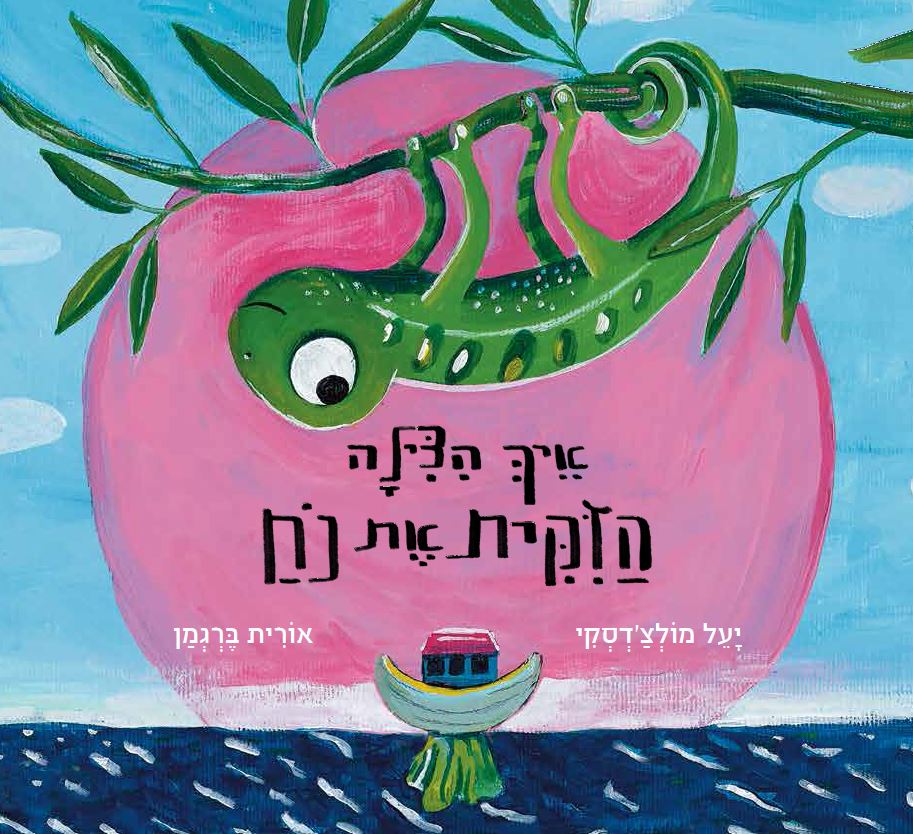How the Chameleon Saved Noah / By Yael Molchidesky
Illustrations: Orit Bergman
Dear Parents,
Who helps whom—does Noah help the chameleon, or the chameleon, Noah? This story, inspired by tales from rabbinic Midrash, is about tending to and caring for a small creature, and depicts the reciprocal relationships among the various creatures in the ark, large and small.
Noah’s Ark
Anyone who has ever had a pet knows the burden of responsibility entailed in caring for an animal. The biblical story of Noah and his family, and the animals that he took with him in the ark, has inspired many generations of tales and stories describing life in the ark and detailing how Noah and his family cared for the varied creatures on board. In vignettes depicting life on board the ark, our rabbis described the devoted care which Noah and his family gave to every single creature, each according to its needs, and the tremendous effort they made to provide each species with the right food.
The story “How the Chameleon Saved Noah” doesn’t merely show us Noah’s devotion to each creature—it also illustrates how a small creature like the chameleon can make itself useful to us humans—teaching us that every creature, no matter how small, is critical to the existence and survival of our planet.
Family Activities
- Stage a family play based on the story. Find simple props at home (sheets and scarves can be used to improvise costumes for Noah and his family; dolls, puppets, and stuffed animals can stand in for the various kinds of animals) and try to imagine the sights, sounds, and smells in the background. Think of ways you could represent the stormy sea, and what might serve as your ark?
- The illustrations that accompany this story add a lot of details that aren’t in the text. Examine the pictures and see if you can identify the different creatures. Can your children name them all? You could divide them up into “family groups” (birds, insects, etc.).What animals do your children know that do not appear in the story? Do your children know how to assign these animals, too, to their “family groups”?
- Noah is concerned about all the creatures on the ark and devotes himself to their care. Talk with your children about the proper way to treat animals, and discuss what “proper care” entails. Take this book with you when you visit a zoo or nature center, and see if you and your children can locate there some of the animals that appear in the book. Some zoos and nature centers let you watch while they feed the animals; others even permit you and your children to participate in the feeding. Do your children know what each type of animal eats, which animals they are allowed to feed, and what food they should be fed? After this visit, you could talk about the differences between domestic pets and wild animals, how we handle animals in captivity, and other related topics.
- “To each his own.” Noah feeds each animal the kind of food that’s appropriate for its species, and he tries very hard to figure out which food will suit the chameleons. Do all the members of your family like to eat the same things? Or do you, like Noah, prepare special foods for different family members, based on individual preferences, allergies, or ages? You could discuss food preferences with your children and see which foods everyone in the family likes, and which are enjoyed only by individual family members.
- Make a model ark out of a shoe box. Ask your children to decorate the model ark as imagination dictates; then put in dolls and either Lego or game pieces to represent Noah, his family, and the various animals.
- This story is based on a Midrash, which in turn was based on the Biblical account of Noah. You could talk about Noah’s character with your children, and retell the story of Noah and the flood. If you know any other Midrashic tales about Noah and the ark, you could share those with your children as well.
Have fun reading and talking about this story!
The Story of Noah and the Chameleon appears in Gemara, Tractate Sanhedrin 108:42
“It is written, ‘After their kinds they went forth from the ark.’ Now, how were you situated?” — He replied. 'We had much trouble in the ark. The animals which are usually fed by day we fed by day; and those normally fed by night, we fed by night. But my father [Noah] did not know what food the chameleon ate. One day he was sitting and cutting up a pomegranate, when a worm fell out of it, which it [the chameleon] consumed. From then onward, he mashed up bran for it, and when it became wormy, the chameleon devoured it.’





